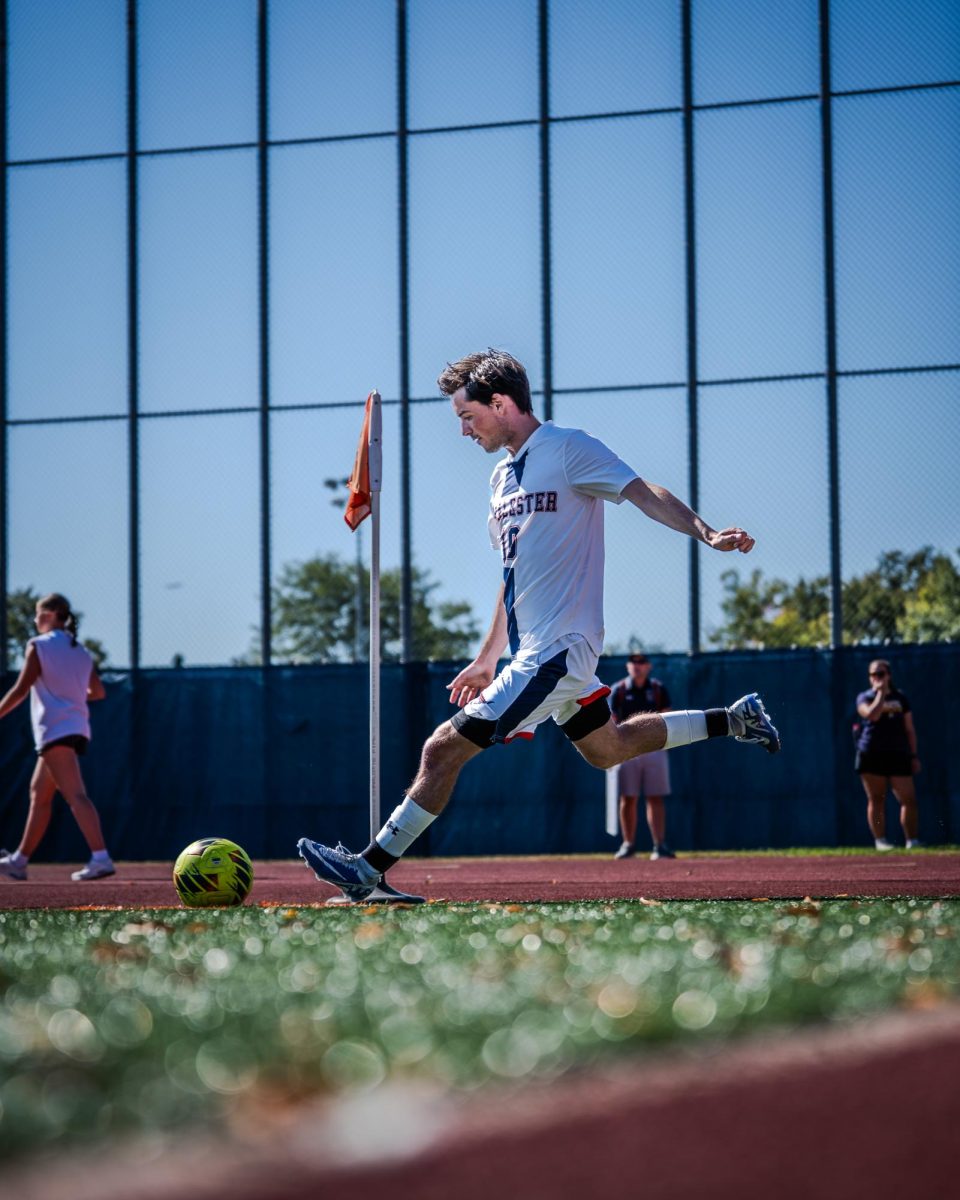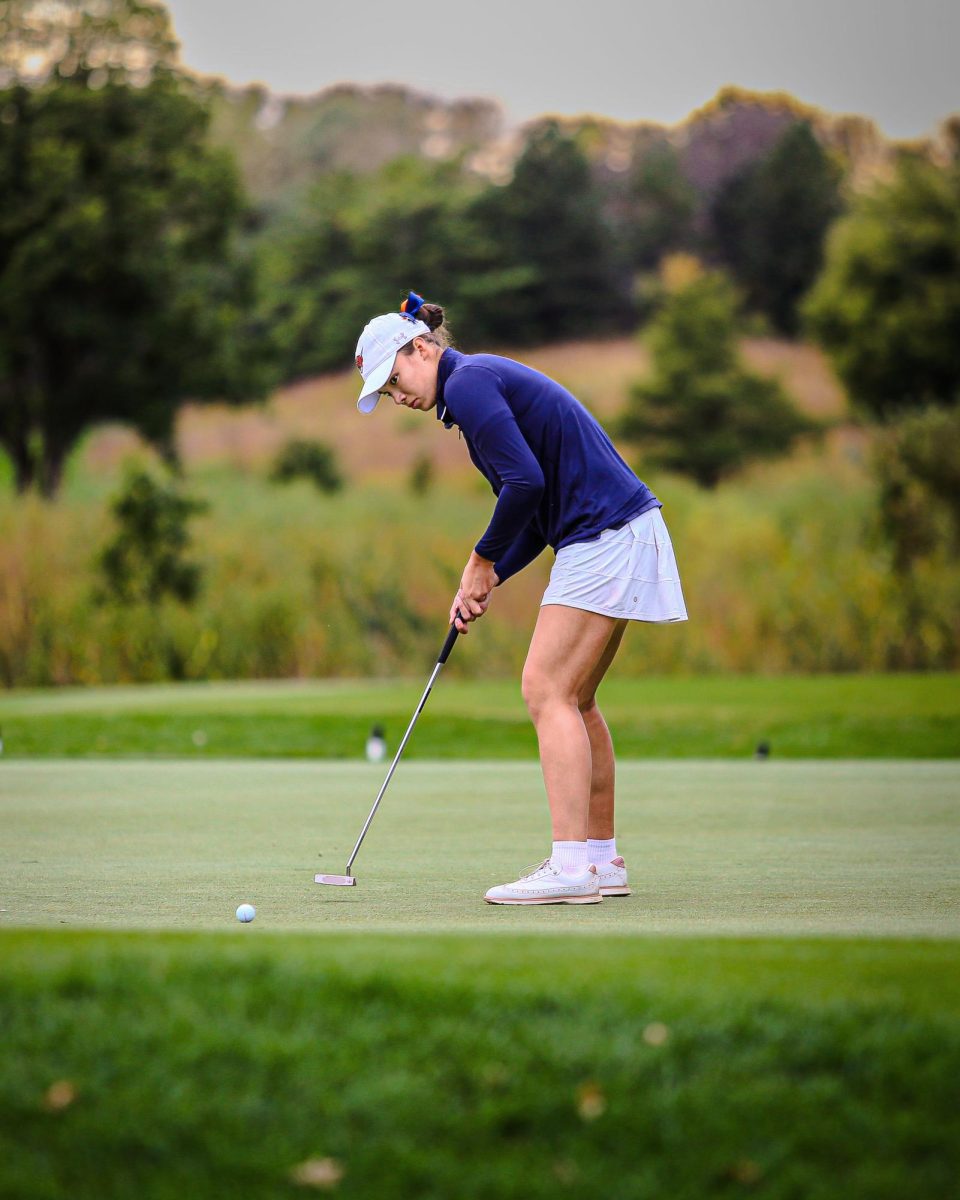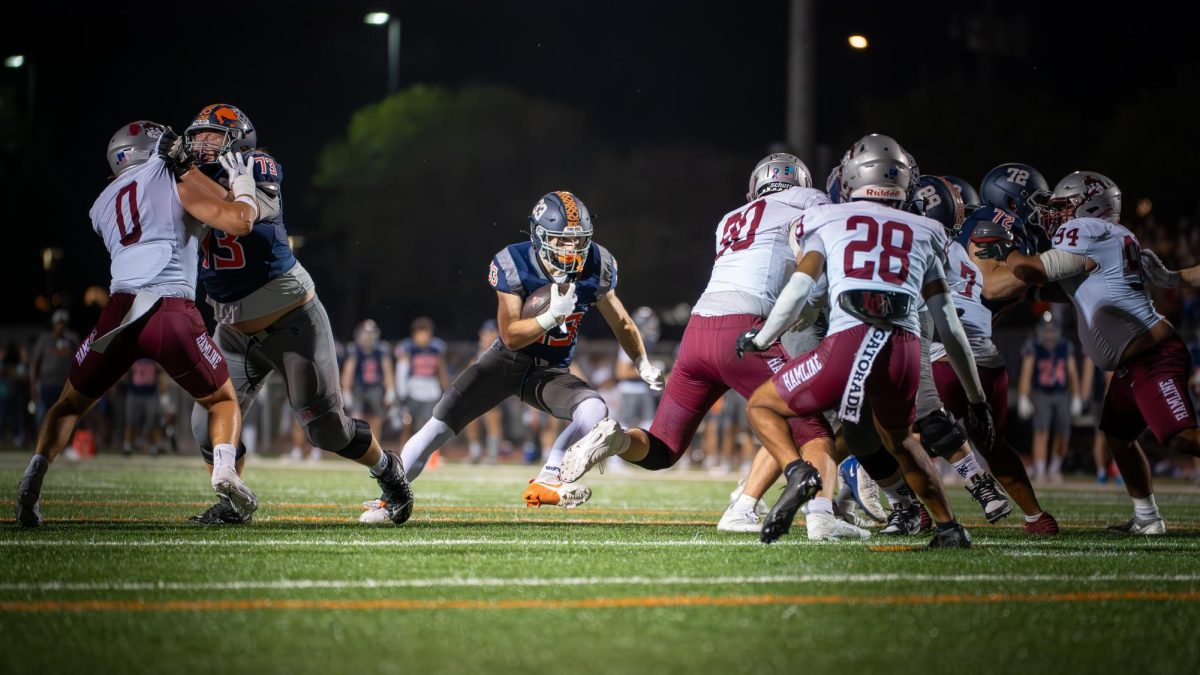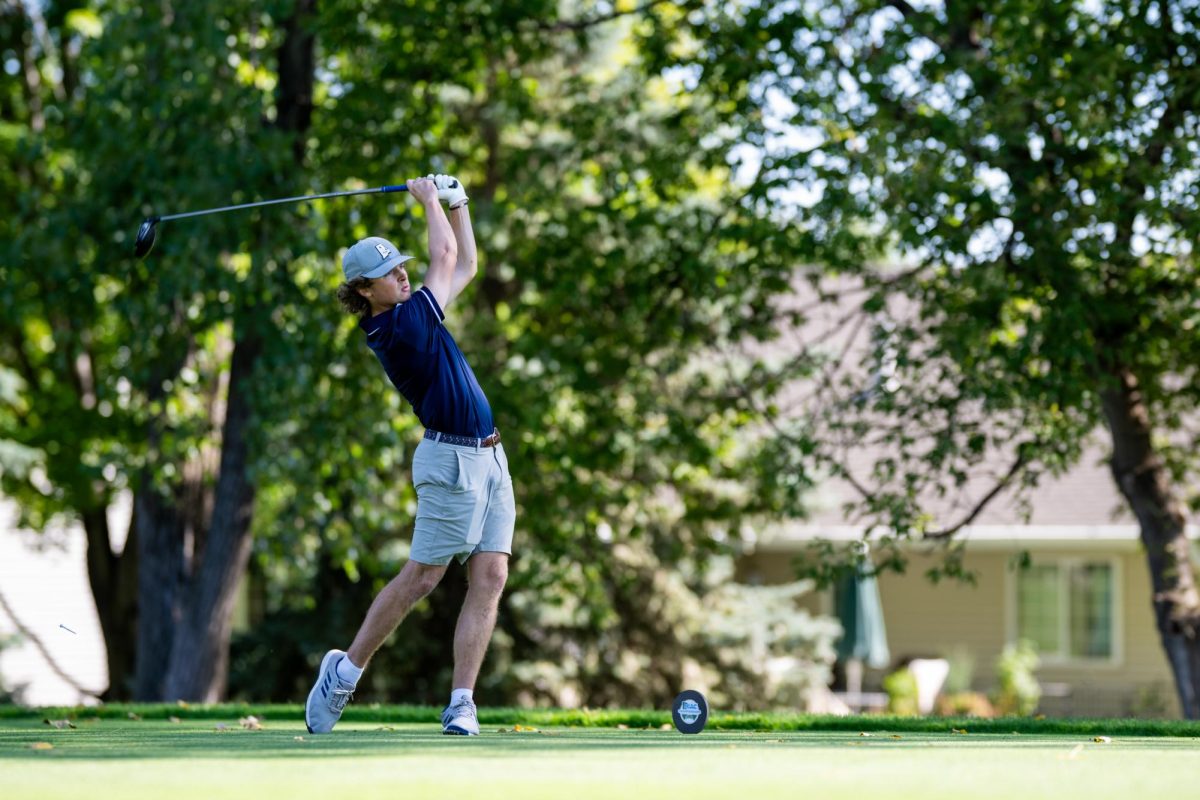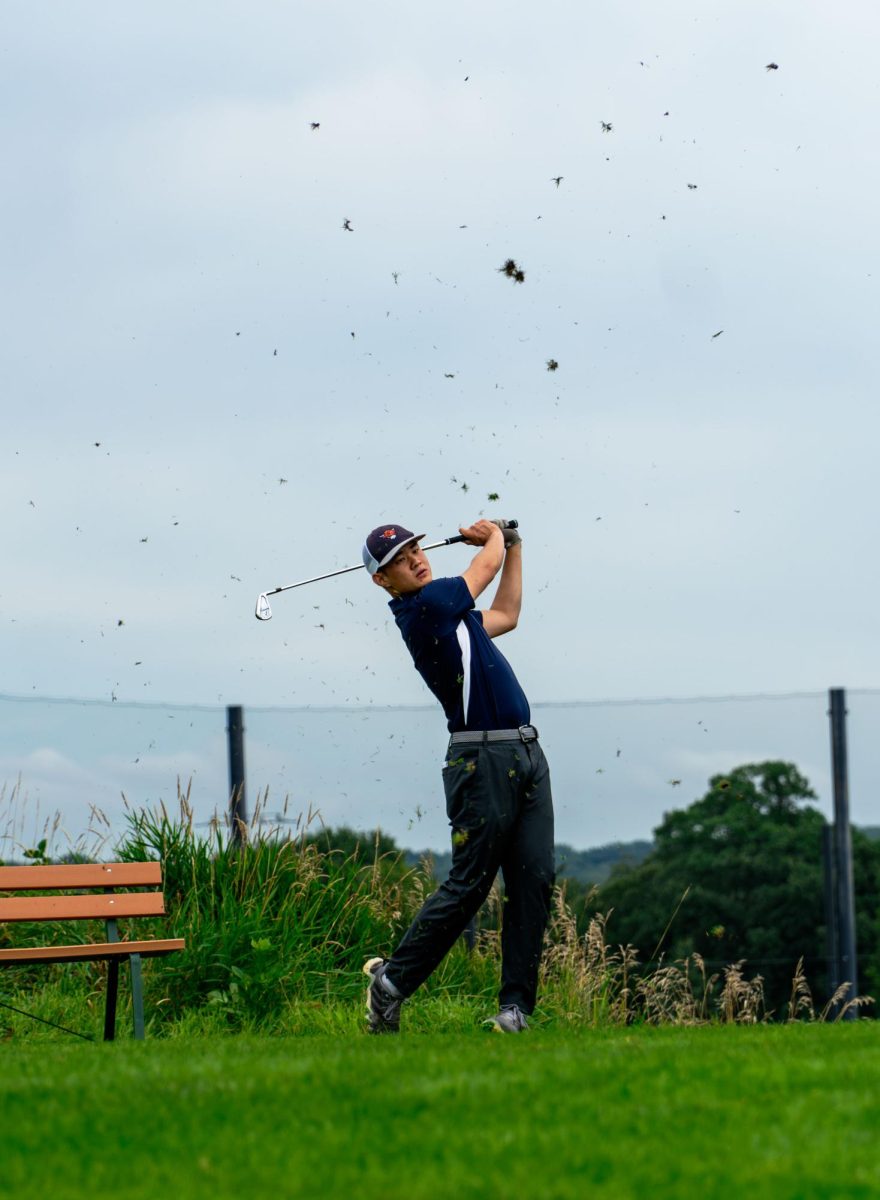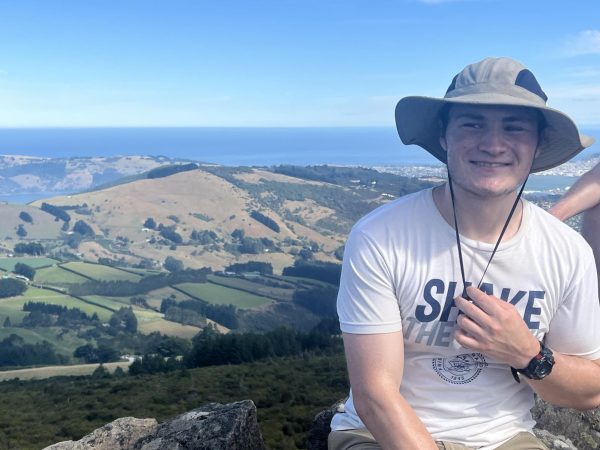On Nov. 22-24, Macalester’s swimming and diving program found itself in a rare situation. The squad split up to appear in two meets on the same weekend. Most swam in St. Peter, in the Nov. 23 Grace Goblirsch Invite at Gustavus Adolphus College. There, the women’s squad came second of six teams, while the men came fourth of six.
The 11 remaining swimming Scots — five from the men’s team and six from the women’s side — traveled south to Chicago for the Phoenix Fall Classic. In the pool against multiple DIII nationally-ranked schools, the 11 in Illinois rewrote program history four times.
Molly Nuckolls’ ’28 200-yard butterfly was the fastest ever for a Scot, while Tommy Moore ’27 took part in three record-breaking swims, individually breaking Macalester’s 100-yard freestyle record and swimming a leg of both the 200- and 400-yard medley relay races that also broke previous Scots’ bests.
These records weren’t a coincidence; the Scots had targeted that weekend. They tapered off their training load to be fresh and put up quick times at the Chicago and Gustavus meets, something Moore named as a factor behind his multi-record-breaking performance in Illinois.
He also came into the meet with an individual focus on ironing out his race strategy: “[What drove a strong performance in the Chicago meet was] explicitly thinking about what I suck at in swimming and how to minimize sloppy mistakes in the back half of all of my events,” Moore wrote in an email to The Mac Weekly.
The Scots came seventh of seven competitors on both the men’s and women’s sides of the meet. Compared to their Minnesota Intercollegiate Athletic Conference (MIAC) rivals, the quality of their Chicago results come into clearer focus; the Scots laid down 22 MIAC-leading times at the Phoenix Fall Classic.
For Head Coach Kyllian Griffin, the Chicago meet was something of a proof-of-concept, both in its format and the team’s preparation.
“It was a decision to send some of those top-end swimmers to a competition with some of the best in the nation and to see where we’re at,” Griffin said. “It was good practice for that prelim/final style meet. And the goal is to help set us up for [the Roger Ahlman Invitational] this weekend … and also for MIACs and hopefully some national [qualifiers] down the road.”
Both the groups swimming at Gustavus and in Chicago followed the same semi-rest regime to target their respective meets. With four meets in the five weekends preceding the critical MIAC championship meet, practicing that short rest program will be key for performing on championship week, when they’ll have a similarly short time to prepare.
The Gustavus meet also featured some of the best divers in the MIAC, giving Scots a chance to see where they stack up against their conference rivals on the board.
Despite the split-squad character of the weekend, the Scots still found ways to stick together; the Chicago group watched the St. Peter swimmers compete on a livestream between their preliminaries and finals and both squads received frequent updates on their counterparts. It’s emblematic of a tight-knit quality that also contributes to the team’s success. Members of the team effused about the togetherness they’ve experienced as Scots.
“We pride ourselves on having one of the best team cultures in the MIAC,” Annika Hensel ’28 said. “That’s a very special thing to [have as] a part of my individual goals. I want to help the team win MIACs this year by contributing in any way that I can, through supporting the team or competing.”
For Will St. John ’26, the people on the team are integral to his experience.
“The team [is] growing; it’s huge and it’s so much fun to be around,” he said. “In my third year, it’s evolved to be the people that [keep me] interested, and why I’m still swimming.”
Griffin described how the team’s growth makes them better.
“The big thing that we talk about a lot is doing it together,” Griffin said. “The fact that we’re better than we’ve ever been is because we’re bigger than we’ve ever been. We have a lot more talent in the pool, which means we have a lot more people in practice pushing each other every single day to be better. And they’ve done a really great job of working together to swim faster. Our dive team is [also] bigger; last year, Dylan [Herlihy ’26] was on the board by himself, second semester. Now we’ve got seven on the board, so that’s a change of pace.”
Managing the structure of a season’s training is all-important. Swimmers must aim to improve through the length of the campaign and peak during championship season in mid-to-late February, so while quick times in November and December are good performance bellwethers, the real targets come later in the season. The records set in Chicago aren’t meant to be this team’s peak: there are still improvements to be made before the all-important conference championship meet.
Those early season bellwethers, however, can still demonstrate the season-on-season rise of a program. These Scots have done that so far with big results in dual meets earlier in the season. For the women, it was a victory over St. Catherine University, 2024 runners-up in the MIAC and champions in the three years preceding that one.
“[The St. Kate’s win] kind of shows we’re doing things the right way; we’re training the right way, we’re putting time in in the right areas,” Hensel said. “And so I feel like it gives us a good idea of where we are. And, for me, it was just very exciting and overwhelming in a good way.”
Two wins by Emma Henry ’26 and by two Scots wins in the meet’s two longest events — the 500- and 1000-yard freestyle swims taken by Molly Nuckolls and Skye Schmit ’25 respectively — punctuated the meet. Schmit is the returning MIAC women’s swimmer of the year, having won three individual MIAC championships in 2024: injuries limited her involvement in the early part of this season, but a return to multi-event form serves to boost these already-strong Scots.
She lamented the slowness of that injury return process, but also described how it has lent her a new appreciation for her time as a member of this team.
“It’s been slow, but it is making me really think about why I love swimming and why it matters to me,” Schmit reflected. “Especially with an injury … It’s so easy to be like, ‘I could just give up,’ especially because it’s my last season. But it’s really made me treasure every practice … I’m really grateful for the practices I do have, and every time I can swim a little bit faster, I’m more grateful than I have been in the past.”
For the men, a defining dual meet came against Carleton College on Nov. 9. On that day they beat the Knights 144-140, building their winning margin with wins in both relays, 1-2 showings in both diving events and double individual wins from Tommy Moore and Kean James Pajarillaga ’28. In the 2023 edition of the same clash, the Knights won 187- 106, so this year’s event marks serious improvement and an encouraging sign for the end-season potential of this team.
“Beating Carleton was a massive goal for us as our teams are very competitively close (especially this year),” Moore wrote. When you have a swim meet that could go either way, Every. Swim. Counts. It was a very stressful meet for me as the points were flipping back and forth between who was winning the entire time … My main takeaway was that there is now objective evidence that the Macalester men’s swim team is beginning to get on par with the higher-performing swim teams of the MIAC, which is very exciting to be a part of. “
After the upcoming home Roger Ahlman Invitation meet on Dec. 6-7, both women’s and men’s Scots have a six-week wait until their next meet and a multi-week break away from formal team practices. Managing that break and making sure these Scots stay on track while off-campus will be crucial to continuing this season’s momentum.
Hensel mentioned going back to swim with a home club team. St. John spoke of an alternate way that these Scots will motivate each other over the break: “We have a competition amongst the team where we see who can accrue the most points for [working out], where if you’re able to get in the water for two hours, you get four points, if you’re able to run, you get one point, or something like that. Winner gets a high five.”
The swim & dive teams will reconvene for a training trip to Arizona, then get back into competition on Jan. 18 with a dual meet against St. Olaf College. That meet starts a one-month second half of the season, culminating with MIAC championships from Feb. 19-22. There, they’ll look to reach heights this program hasn’t seen in multiple decades.
With a season starting in September and ending in February, the swim & dive campaign is a five-month grind of training and improvement. Come championship season in February, the team will see it pay off. For the men’s side of this program, the goal will be to improve their standing in the conference and beat some opponents who’ve gotten the best of them in recent years. For the women’s squad, if they stay the course and things fall into place, they could be MIAC champions for the first time in program history.


